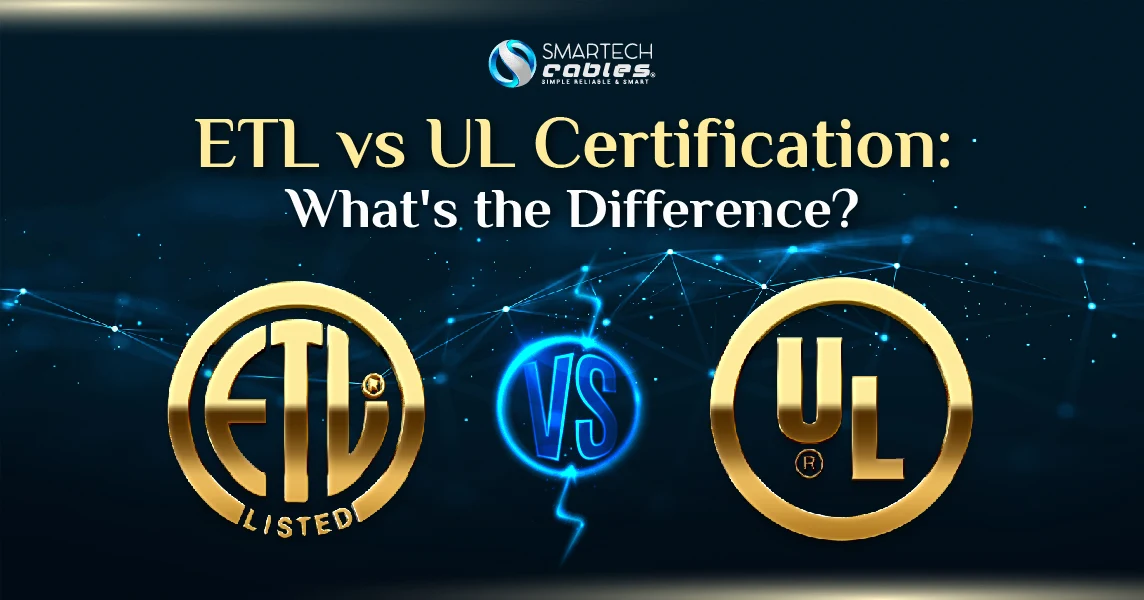ETL vs UL Certification: What's the Difference for Your Products?

Have you ever bought a new electronic gadget or appliance and wondered if it’s safe to use? You're not alone! In the United States, product safety is a significant concern, and two names often come to mind: UL and ETL. Many people search for these terms because they want to know that their products meet high safety standards. But what exactly do UL and ETL mean? And more importantly, what are the differences between them?
This blog post will help you understand these essential safety certifications. We'll break down what ETL and UL certification are, why they matter for electrical products, and how they ensure your devices are safe and reliable. We’ll look at the differences between the two marks, so you can confidently choose products that meet industry standards. By the end, you’ll know exactly what to look for when you see the UL Listed or ETL Listed mark. Keep reading to learn how these certifications protect you and your home!
What is ETL Certification?
Think of ETL certification like a trusted friend who double-checks your homework. The ETL listed definition is simple: it means a product has passed rigorous safety tests by ETL laboratories, which is part of Intertek. When you see the ETL mark on your Cat6 Ethernet cable or power adapter, it's telling you, "This product won't burn your house down."
ETL Listed Meaning:
What does ETL stand for? Originally, ETL meant Electrical Testing Laboratories. Today, it's evolved into something bigger. ETL listed means your electrical products have been tested to the same safety standards as those used by UL. It's like having two different mechanics inspect your car using the same checklist—both know what they're doing.
The ETL certification meaning goes beyond just a pretty mark on your device. When manufacturers get ETL approval, they're proving their products meet NRTL (Nationally Recognized Testing Laboratory) standards. This matters whether you're purchasing Bulk Cat6 cables for your home office or establishing an entire network infrastructure, emphasizing the importance of structured cabling.
The ETL Certification Process: How Products Get ETL Listed for Safety
Getting ETL approved isn't like getting a participation trophy. Here's what happens:
- Initial Testing: Products undergo comprehensive safety evaluations
- Standards Compliance: Must meet ANSI/UL standards for electrical safety
- Factory Inspections: Manufacturing facilities get regular check-ups
- Ongoing Monitoring: ETL keeps watching to ensure quality stays consistent
What does ETL certification mean in practical terms? It means your Cat6 plenum cable has been torture-tested for fire resistance, electrical safety, and performance reliability.
|
ETL Certification Features |
Benefits of Network Equipment |
|
NRTL Recognition |
Accepted by inspectors nationwide |
|
OSHA Compliance |
Legal for workplace installations |
|
Same Standards as UL |
Equal safety without premium pricing |
|
Factory Audits |
Consistent quality control |
What is UL Certification?
UL is like the grandfather of electrical safety; it has been around since 1894, setting the rules that everyone else follows. UL listed what does it mean? It means Underwriters Laboratories has not only tested your product but also created the safety standards it follows.
UL Listed vs UL Certified:
Here's where things get interesting. UL certification vs listing isn't just semantics—there's a real difference:
- UL Listed: Product meets UL's safety standards for specific applications
- UL Certified: Product meets performance standards beyond just safety
- UL Labeled: Meets UL standards for particular markets or regions
When you're shopping for Cat6 vs Cat6a cables, you'll typically see "UL Listed" rather than "UL Certified." This indicates that the cable is safe for electrical installations, but doesn't necessarily address its data transmission performance.
The UL Testing Process: Why It Takes Longer
UL doesn't just test products—they create the playbook. This is why UL vs ETL certification often comes down to time and cost. UL's process includes:
- Standards Development: Creating new safety requirements
- Comprehensive Testing: Often more extensive than ETL
- Market Research: Understanding real-world applications
- Ongoing Innovation: Continuously updating standards
Think of it this way: UL writes the recipe, while ETL follows it perfectly. Both create delicious (safe) results, but one takes longer and costs more.
ETL vs UL Certification: The Real Differences That Matter
Now for the million-dollar question: Is ETL listed the same as UL listed? In short, yes, for safety purposes. Long answer: It's complicated, and the details matter for your specific needs.
Safety Standards: Are They Actually Equivalent?
Is ETL and UL the same when it comes to ensuring your equipment's safety? According to OSHA, absolutely. Both certifications must meet identical safety requirements. Your Cat5e Ethernet cable with an ETL mark is just as safe as one with a UL mark.
However, here's where ETL vs UL safety listing gets nuanced:
|
Aspect |
ETL Listed |
UL Listed |
|
Safety Standards |
Identical (follows UL standards) |
Original standards creator |
|
OSHA Recognition |
Full acceptance |
Full acceptance |
|
Testing Rigor |
Same requirements |
Same requirements |
|
Market Perception |
Newer, cost-effective |
Traditional, premium |
|
Processing Time |
Typically faster |
Often longer |
Cost and Timeline: Where ETL Shines
ETL versus UL in terms of budget? ETL typically costs 20-40% less and processes 2-3 weeks faster. For manufacturers of Ethernet cable accessories, this can mean significant savings without compromising safety.
Market Acceptance: The Perception Game
Here's the truth about UL vs ETL certification: Some buyers still think UL is "better" because it's older and more established. It's like preferring name-brand medication over generic—both have identical active ingredients, but one feels more premium.
Is ETL as good as UL? From a safety standpoint, absolutely. From a marketing standpoint, UL still holds the edge in specific markets, especially commercial installations, where specifiers tend to default to familiar names.
ETL Listed vs UL Listed: Product-Specific Considerations
When you're choosing between ETL listed vs UL listed products, context is everything. Let's break down what matters for different types of networking equipment.
Power Adapters and AC Accessories
What is ETL certified AC power adapter's safety compared to UL? Identical. Both must pass the same electrical safety tests. Whether you're powering a router, switch, or patch panel, ETL certified power supplies offer the same protection as UL alternatives.
ETL adapter benefits include:
- Same safety standards as UL
- Often lower cost to consumers
- Faster time-to-market for manufacturers
- Full OSHA compliance
Ethernet Cables and Network Infrastructure
For Cat6 shielded plenum cables and other network infrastructure, ETL vs UL listed comes down to application requirements:
Commercial Installations:
- Some specs still require a UL listing specifically
- Architects and engineers may prefer a familiar UL marking
- Insurance companies sometimes have preferences
Residential and Small Business:
- ETL listed products offer identical safety at lower costs
- Performance characteristics are equivalent
- Installation requirements are the same
LED Lighting and Smart Devices
ETL listed lighting has gained significant market share because LED manufacturers can get to market faster with ETL certification. ETL LED products must meet the same safety standards as UL alternatives, including:
- Fire resistance testing
- Electrical safety verification
- EMI/EMC compliance
- Environmental stress testing
|
Product Category |
ETL Advantages |
UL Advantages |
|
Power Adapters |
Lower cost, faster certification |
Traditional market preference |
|
Ethernet Cables |
Cost-effective safety compliance |
Specification requirements |
|
LED Lighting |
Rapid innovation cycles |
Established market presence |
|
Network Equipment |
Budget-friendly without safety compromise |
Premium brand association |
How to Verify ETL and UL Certifications
ETL listing directory searches and UL database lookups are your best friends when verifying certifications. Don't just trust the mark—verify it.
Reading Certification Marks Correctly
ETL marking includes specific information:
- ETL logo with "us" or "c" for US/Canada
- File number for database verification
- Product category designation
UL mark variations tell different stories:
- UL Listed mark for safety compliance
- UL Recognized mark for components
- UL Classified mark for specific uses
Online Verification Tools
Both ETL listing and UL databases are publicly accessible:
- ETL Verification: Visit Intertek's certification directory
- UL Verification: Use UL's online product database
- Cross-Reference: Match file numbers with product specifications
Pro tip: When buying Cat6 keystone jacks or other critical infrastructure components, always verify certifications online before installation.
ETL or UL for Your Networking Needs
UL or ETL, which should guide your purchasing decisions? Here's a practical framework:
Choose ETL Listed:
- Budget is a primary concern
- You're buying for residential or small business use
- Speed to market matters for your projects
- You understand that safety standards are identical
Choose UL Listed:
- Project specifications require UL specifically
- You're in a conservative industry (healthcare, finance)
- Brand perception matters to your end customers
- You need the broadest possible acceptance
The Bottom Line on ETL vs UL
ETL and UL certifications both ensure your networking equipment is safe, reliable, and compliant. Whether you're installing Cat6A bulk cable in a data center or setting up a home office with Cat5e plenum cable, both certifications provide equal protection.
The real question isn't "ul vs etl" for safety—it's about cost, timeline, and market preferences. ETL certified definition and UL listed definition describe products that meet identical safety requirements through slightly different paths.
For most networking applications, ETL listing vs UL listing comes down to practical considerations rather than safety differences. Both will keep your equipment running safely and your installations code-compliant.
FAQ's ETL vs UL Certifications
Let's bust some myths that might be costing you money or causing unnecessary confusion.
UL is Always Better Quality
ETL vs UL certified products meet identical safety standards. Quality depends on manufacturing, not the certification body.
ETL Listed Products Aren't Accepted Everywhere
OSHA recognizes both equally. Some specifications may require UL specifically, but that's specification preference, not a safety requirement.
ETL Certification is Easier to Get
An ETL safety listing requires the same testing as a UL listing. The difference is in standards development, not testing rigor.


